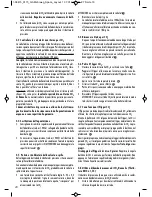
15
CO
2
supply for 24 hours (close pressure reducer/solenoid valve). If
there is water in the test hose after this 24-hour period, this indicates
a leak on the backflow check valve.
The opening of the check valve can only be tested with CO
2
, as a mi-
nimum pressure of approx. 0.3 bar is required to open the valve. It
is not possible to "blow through" the valve with your mouth.
Important note: Use only check valves designed for use with CO
2
, such
as the
special CO
2
check valve from Dennerle
. Standard air
check valves may become brittle through contact with CO
2
within only
a short space of time, resulting in leaks.
Corrosion damage on the pressure reducer/solenoid valve
as a result of water entering into the device is excluded
from the guarantee coverage.
5.3 Replacing the washer
•
We recommend replacing the washer (art. no. 3056) in the ad-
apter for connection to reusable cylinders on a regular basis in
order to rule out leaking cylinder connections at all times.
쏹
•
If necessary, the washer (art. no. 3035) in the pressure reducer
can be levered out carefully with the aid of a small screwdriver,
which should have no sharp edges (!) IMPORTANT: Be careful not
to damage the sealing surfaces!
쏹
5.4 Cleaning and recalibrating the needle valve
There is a factory-calibrated needle valve in the hose connector of the
pressure reducer.
Should no CO
2
be supplied although the cylinder is full and the setting
knob is turned to fully open position, this indicates that the needle valve
is probably blocked. In this case:
•
Open the valve by turning by one half-turn in anti-clockwise di-
rection using a fine screwdriver (blade format 2 – 2.5 x 0.5
mm), then "flush" with CO
2
for a few seconds with the setting
knob in fully open position.
IMPORTANT: Do not unscrew valve completely!
쏹
•
Close valve again by one half-turn.
•
The valve is factory-set to approx. 120 bubbles per minute when
the setting knob is in fully open position. If necessary, it can be
recalibrated by carefully screwing it in or out in steps of approx.
1/8 of a turn.
5.5 Removing the CO
2
hose
After prolonged service, the CO
2
hose may be very firmly atta-
ched to the connector of the pressure reducer and other CO
2
equipment. To remove the hose, it is best to lever it off using a
small screwdriver. Do not pull the hose off by force or cut it open
with a knife, as this may cause damage to the hose connectors!
쏹
5.6 Clean CO
2
Flipper
•
Remove CO
2
collector by pulling straight up.
쏹
•
Place the Flipper flat in your hand so that the suction clips are
pointing to the right. Slide front side panel of the Flipper up-
wards by approx. 2 cm.
쏹
•
Fold out side panel.
쏹
•
Take out CO
2
hose, do not pull out.
쏹
•
Clean all parts with warm water and a soft sponge. Do not use
any cleaning agents.
•
Re-assemble Mini-Flipper via the reverse procedure.
IMPORTANT: Insert CO
2
hose in the side panel so that the end is
located at the bottom stop.
5.7 How the CO
2
Flipper works
The Flipper is a modern, highly effective CO
2
diffusor which ensures
the most efficient possible use of the valuable CO
2
fertilizer.
While CO
2
bubbles rise slowly in the Flipper, the CO
2
dissolves in the
aquarium water. At the same time, other gases which are naturally
dissolved in the aquarium water penetrate into the CO
2
bubbles. These
“waste gases” explain why the bubbles do not dissolve completely,
despite becoming smaller as they rise in the aquarium water.
쏹
The waste gases are substantially lighter than the relatively heavy CO
2
and thus accumulate in the CO
2
collector at the top. Here they are
discharged regularly via the special
waste gas vent.
The running-in period for the Flipper is approx. 2 days.
In-
itially, the individual CO
2
bubbles combine to form larger bubbles. As
soon as a biological surface layer of microorganisms has formed, the
bubbles rise up to the collector.
5.8 Using disposable Dennerle CO
2
cylinders
(connection thread M10 x 1.25)
The Space pressure reducer can also be used in combination with Den-
nerle disposable CO
2
cylinders:
•
Unscrew the adapter for reusable cylinders with the aid of the en-
closed 6 mm Allen key.
•
Using the spanner, screw the adapter (art. no. 2997) slowly and
without canting into the connection socket of the pressure redu-
cer, tighten firmly.
쏹
•
Turn setting knob as far as it will go in direction "-" (CO
2
supply
shut off).
•
Check whether the washer in adapter and the sealing surface of
the cylinder valve are clean.
•
Screw pressure reducer slowly into place without canting, until a
slight resistance becomes noticeable: This indicates that the pin
in the adapter has established contact with the cylinder valve.
Then swiftly turn the pressure reducer by roughly a further half-
turn and tighten finger-tight. A brief hiss may occur at this point.
쏹
•
The pressure reducer can be unscrewed again at any time – the
cylinder valve closes automatically. A brief hissing sound may
also occur when unscrewing the pressure reducer – it is thus ad-
visable to unscrew the pressure reducer swiftly at the beginning.
25
26
30
22
31
23
24
28
29
27
32
1-08415_0115_GA Mehrweg_Space_Layout 1 07.01.2015 11:27 Seite 14














































